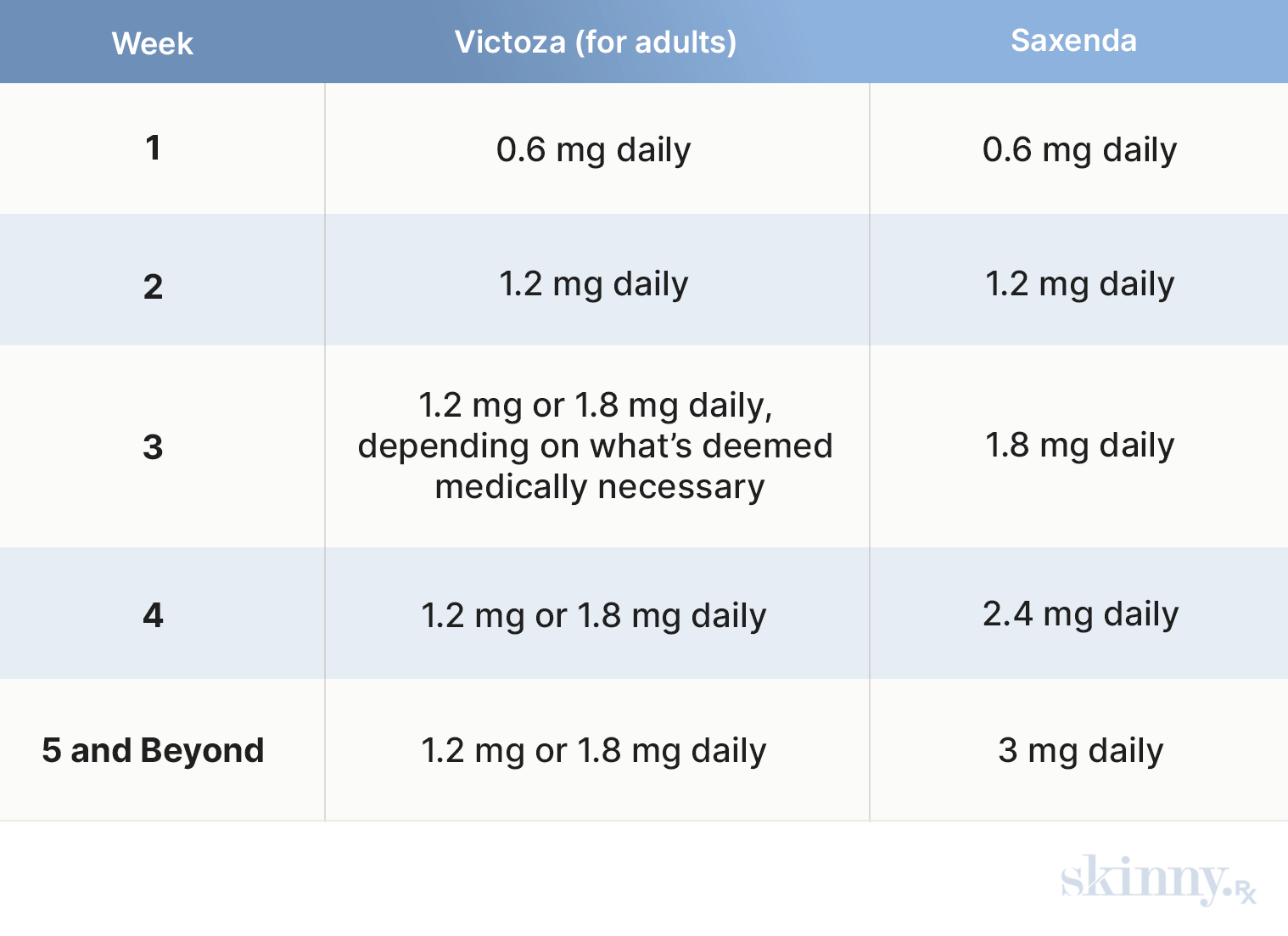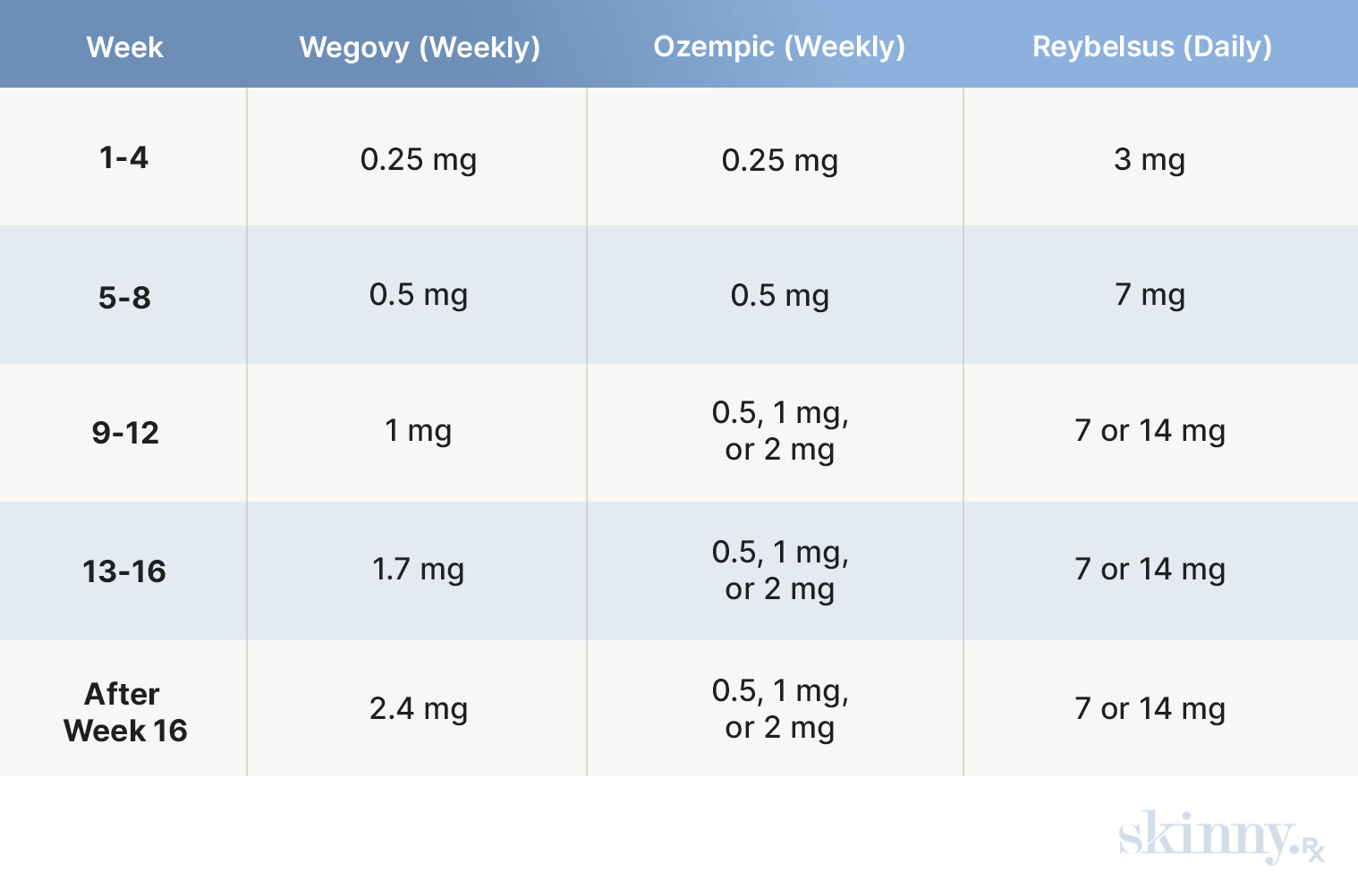
Key Takeaways
- Semaglutide leads to significantly more weight loss than liraglutide, with some studies showing up to 15.8% weight loss compared to 6.8% for liraglutide.
- Semaglutide is available as a weekly injection or daily tablet, while liraglutide must be injected daily, making semaglutide more convenient for many users.
- Both drugs share similar side effects—mostly gastrointestinal—but semaglutide may cause slightly more GI issues than liraglutide.
- Although semaglutide is more expensive overall, it offers more weight loss per dollar spent compared to liraglutide.
- Liraglutide has been FDA-approved longer than semaglutide, which strengthens its long-term safety profile, especially for younger populations.
The words semaglutide and liraglutide sound similar, and these two medications actually offer comparable benefits. Both facilitate weight loss, can help manage type 2 diabetes, and lower the risk of cardiovascular events, like a heart attack or stroke.
Despite all they have in common, liraglutide and semaglutide have some key differences, including that semaglutide performs better in terms of weight loss and blood sugar control in most clinical studies.
Learning how the two diverge in terms of effectiveness, price, and side effects is important when deciding which one suits your needs.
Key Differences at a Glance
What Are Semaglutide and Liraglutide?
Both semaglutide and liraglutide are glucagon-like peptide 1 (GLP-1) receptor agonists. This means they mimic the naturally occurring hormone with the same name, GLP-1, which regulates blood sugar and appetite.
GLP-1 medications are often thought of in relation to weight loss—and they do help individuals drop pounds—but they also offer other benefits: increased insulin production, lower blood pressure, lower cholesterol levels, slower digestion, and feeling fuller after eating.
The main differences between liraglutide and semaglutide stem from what type of GLP-1 receptor agonist they are. Liraglutide is a short-acting compound, meaning the drug is active for less than a day. Semaglutide is a long-acting compound, meaning it circulates for about a week.
Long-lasting and short-acting compounds differ on a molecular level. As a long-lasting compound, semaglutide’s structure means it binds more tightly to albumin, a protein in the blood, making it stay in the body much longer. Since liraglutide doesn’t have this same structure, it won’t bond as strongly and is broken down and cleaned from the body faster. As a result, many semaglutide brands are only taken once a week while liraglutide must be taken every day to achieve the same results.
FDA-Approved Uses
There are FDA-approved versions of liraglutide and semaglutide. Both are available in two to three different brand name medications, each approved for different purposes. On the liraglutide front, there’s Victoza and Saxenda, as well as a FDA-approved generic option. Semaglutide includes Ozempic, Wegovy, and Rybelsus.
Liraglutide Approved Uses
Saxenda (liraglutide) is approved solely for weight loss in specific populations:
- Adults with a BMI of 30 or higher
- Adults with a BMI of 27 or higher and a weight-related comorbidity, such as type 2 diabetes or heart disease
- Children 12 years of age or older with a body weight above 60 kg
Victoza (liraglutide) is approved to:
- Improve control of blood sugar in adults or children 10 years or older with type 2 diabetes
- Reduce cardiovascular risks in adults with type 2 diabetes
In December of 2024, the FDA approved a generic version of Victoza for the same uses as name-brand Victoza. It’s referred to as simply “liraglutide.” There are no approved generic versions of Saxenda, though compounded versions may be available.
Compounded medications are custom-prepared in licensed laboratories. While legal to purchase with a prescription, they are not FDA-approved, which means the consistency, quality, and amount of active and inactive ingredients cannot be guaranteed.
Semaglutide Approved Uses
Ozempic (semaglutide) is approved to:
- Improve blood sugar control in adults with type 2 diabetes
- Reduce cardiovascular risks in adults with type 2 diabetes
Wegovy (semaglutide) is approved to:
- Reduce cardiovascular risks in adults with obesity (a BMI of 30 or above) or in adults with established heart disease
- Promote weight loss in adults and children 12 years or older with obesity or adults with a BMI of 27 or above and one weight-related comorbidity
Rybelsus (semaglutide) is approved to:
- Improve blood sugar control in adults with type 2 diabetes
No FDA-approved generic version of semaglutide exists. That said, there’s compounded semaglutide, which falls into the same camp as compounded liraglutide: it must be made in a licensed pharmacy, but the FDA doesn’t guarantee the safety, quality, or efficacy of the compounded drug.
Dosage Forms & Frequency
Because liraglutide is short-acting, it must be taken daily. It’s only available in an injection form, meaning it may not be a viable option for those who are needle adverse. Semaglutide is available as a once daily tablet (Rybelsus) or a once weekly injection (Ozempic and Wegovy), both of which may better suit those who avoid needles when possible.
The exact dosage schedules vary by brand name drug. For liraglutide, that timeline looks like:


Compounded semaglutide and compounded liraglutide don’t have set dosing schedules. To figure out dosage for compounded medications, work with a pharmacist or doctor who understands the exact breakdown of the medication and how to safely prescribe compounded medications.
Semaglutide vs Liraglutide Effectiveness Comparison
Weight Loss Results
Semaglutide is the clear front runner for weight loss. A study comparing the two found the average body weight reduction in one year of liraglutide was 2.2% and semaglutide was 5.1%. And it’s not the only study to suggest semaglutide is better for weight management. A 2022 study found that in 68 weeks, participants lost 15.8% body weight with semaglutide compared to 6.8% with liraglutide.
Blood Sugar Control
Both are options for blood sugar control, though semaglutide performs better on the Hemoglobin A1C (HbA1C) test, which shows average blood glucose (blood sugar) levels over the last two to three months. Liraglutide decreased HbA1C by 0.9 to 2.2% and semaglutide from 1 to 3%. On the surface, those percentages appear similar, but keep in mind there’s a huge difference in even a 0.01% decrease in blood glucose levels.
Plus, another study analyzed 14 clinical trials on managing blood sugar with semaglutide and liraglutide. It found semaglutide outperformed liraglutide in terms of blood sugar control.
Side Effect Profiles
Semaglutide and liraglutide have many of the same side effects. Common ones the two share include:
- Nausea
- Diarrhea
- Constipation
- Vomiting
- Stomach pain
- Yellow skin or eyes
- Fever
- Sweating
- Lightheadedness
- Anxiety
- Faster heartbeat
- Shakiness or weakness
- Headaches
- Blurred vision
- Fatigue or drowsiness
More severe side effects are rare but may include:
- Difficulty breathing due to severe allergic reactions
- Cancerous or noncancerous tumors in the thyroid
- Kidney problems, including kidney failure
- Increased risk of low blood pressure, which can be life-threatening if left untreated
How widespread and severe these side effects differ based on the individual and drug.
Common GI Issues
Gastrointestinal (GI) issues are some of the most common side effects of GLP-1 medications. These include any side effects in the GI tract, such as nausea, diarrhea, constipation, or vomiting. In one clinical trial, 82.7% of participants taking liraglutide and 84.1% of participants on semaglutide reported GI issues. This means GI side effects are relatively common in both, though slightly more so for semaglutide than liraglutide.
Long-Term Safety
In clinical trials, both liraglutide and semaglutide were safe for most study participants, except in rare cases where adverse effects, usually extreme side effects, were experienced. In fact, a 2024 study reported that semaglutide is safe for diverse populations, while a 2013 study found the same for liraglutide. The 11-year gap in those studies also brings up another key difference: Liraglutide has been FDA-approved for much longer than semaglutide, strengthening its safety profile.
That said, some people do experience adverse reactions to both medications. If someone starts either medication and experiences side effects, a medical provider or pharmacist can provide guidance, potentially recommending a smaller dose or alternative medication.
Cost and Accessibility
Neither liraglutide nor semaglutide is cheap if paying out-of-pocket, as reflected in the table below:
When comparing injected versions of each, Liraglutide costs $16,373.54 annually and semaglutide’s annual cost was $17,543.07, noting that the researchers pulled these numbers from GoodRx, not the original manufacturers, so they might differ from the table above.
The researchers also noted that semaglutide is cheaper per % of body weight loss ($1,845 for 1% body weight loss on semaglutide compared to $3,256 for liraglutide). While liraglutide is cheaper overall, semaglutide provides more value for money spent.
Insurance Coverage
Insurance coverage varies, though most insurance plans cover FDA-approved medications, including brand name liraglutide and semaglutide options. When either is covered, insurance providers require a doctor to submit a request detailing why the medication is medically necessary. An insurance provider can then reject or approve the request. When rejected, a doctor and patient can appeal, and the insurance company is required to respond within 30 days.
Which One Should You Choose?
The best choice isn’t always clear, but semaglutide offers some unique advantages: it facilitates more weight loss and better blood sugar control in the studies we reviewed. It also provides more value for your money, though it is more expensive overall. Semaglutide also tends to be better for needle-adverse patients, since it can be taken as a daily tablet or a weekly injection, whereas liraglutide is a daily injection.
There is a marginally higher rate of GI side effects for semaglutide, meaning those with GI conditions may prefer liraglutide. Liraglutide and semaglutide also perform relatively similarly in terms of reducing cardiovascular risk, and liraglutide is FDA-approved for children 10 years or older, while semaglutide is approved for children 12 years or older.
Switching Between Medications
It’s safe to switch between liraglutide and semaglutide, though the transition isn’t always easy since liraglutide is taken daily while injected versions of semaglutide are weekly. That difference can cause some confusion around dosage when switching. As a result, it’s important to work with a doctor if switching medications.


 Medically Reviewed
Medically Reviewed--Key-Differences.jpg)



